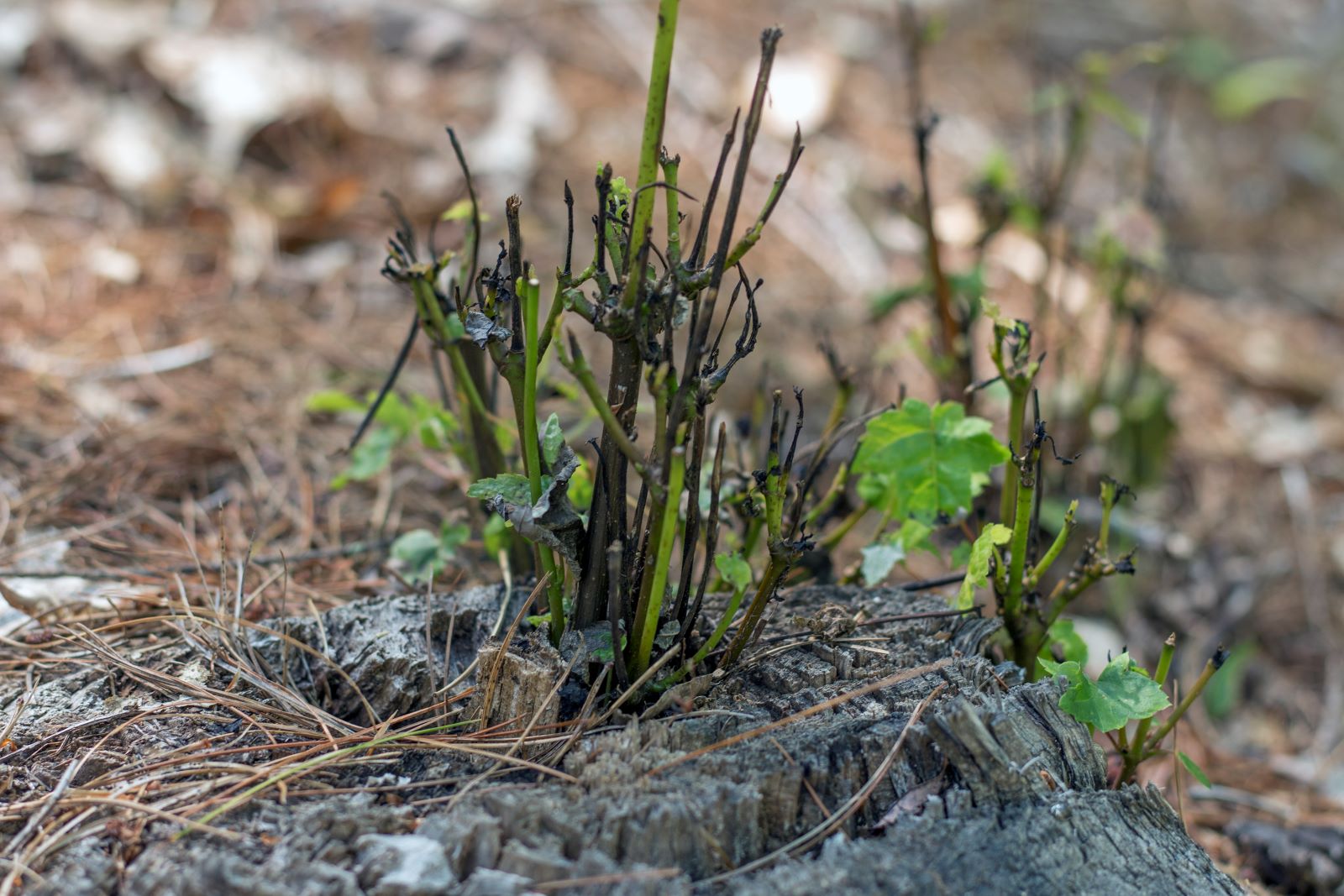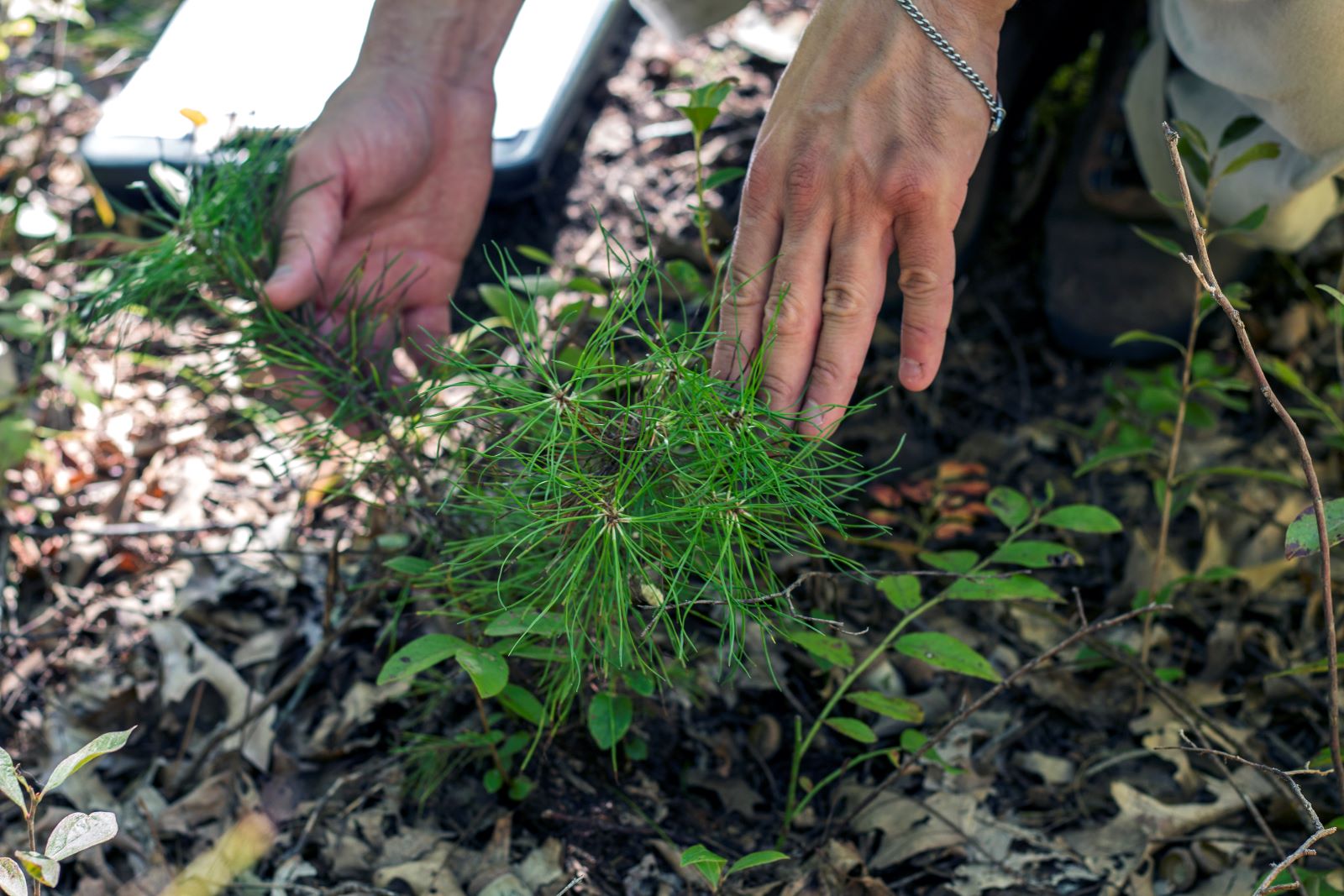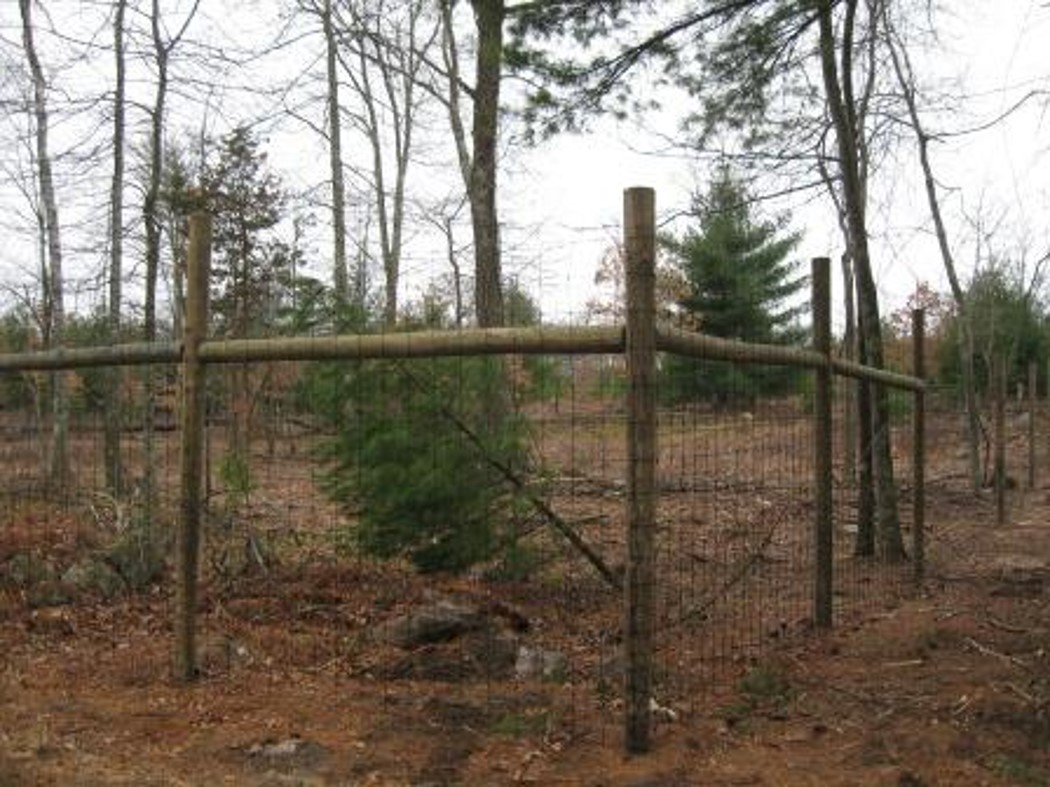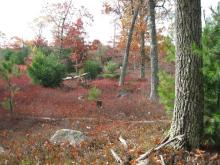Secondary tabs
Submission information
| Study Title | Tunk Hill Experimental Climate Adaptation Planting |
|---|---|
| Case Study Type | Forest type, Forest health, Management type |
| Management Subcategory | forest adaptation, ecological restoration |
| Site Photo |
|
| Image caption | Planting site conditions |
| Lay Summary | Providence Water implemented an experimental "transition" climate adaptation planting seeking to improve regeneration in an area of forest surrounding the state's main reservoir. Seedlings both native and novel tree species projected to be adapted to future climate conditions were planted in an area that experienced oak regeneration failure. Half of the seedlings of each species were planted within a deer exclosure fence and half were planted in an unfenced area nearby. Annual monitoring has allowed for comparison of survival and growth of the planted trees at these two sites since 2015. The difference in tree survival rates between the fenced and unfenced sites is largely attributed to deer herbivory. |
| Location | Scituate, Rhode Island |
| Location Description | Providence Water property between Scituate Reservoir and Tunk Hill Road |
| Latitude | 41.775000 |
| Longitude | 71.604000 |
| Directions | N/A for public website |
| Accessibility | Not accessible to the public without specific permission |
| Landowner Name | Providence Water |
| Landowner phone | +1 401-521-6300 |
| Landowner email | rmacmillan@provwater.com |
| Stand Area with Units | 12 acres total (6-acre deer exclosure and similar-sized area of larger unfenced stand) |
| Cover Type | Mixedwoods |
| Natural Community Classification | Oak-Pine Forest |
| Plant Community/Habitat Class Growth Stage | Early successional |
| Primary Forest Health Threat | deer |
| Secondary Forest Health Threats | drought |
| Primary Pests/Disease | orangestriped oakworm |
| Secondary Pests/Disease | gypsy moth |
| Soils | Canton and Charlton fine sandy loams, very stony |
| Estimated Stand Year Origin | 2007 |
| Stand Origin Year Note | Harvests with different silvicultural goals established similar stand conditions at the paired planting sites located within a few hundred feet of each other. |
| Start date | Tue, 05/05/2015 - 00:00 |
| End date | Fri, 05/08/2015 - 00:00 |
| Stand History | Much of the area is a poor upland oak growing site with rocky and well-drained soils that was acquired relatively recently and is not part of the historic ownership. A shelterwood timber harvest was conducted around 2007 but many of the remaining canopy trees died in part due to drought and repeated defoliation by the orange-striped oakworm and other pests. Some young white pine had established, but otherwise the site was largely an example regeneration failure. A nearby stand of planted red pine became infected by the red pine scale and adelgid. The trees were cut before they died in an effort to capture their timber value and to try to establish regeneration, but the high deer population and invasives inhibited native tree and plant establishment. With support from a grant, a 5-acre deer exclosure fence was constructed in 2011 and invasive plants inside were treated as a demonstration. Although these sites located within a few hundred feet of each other had different management histories, in 2015 they were both in relatively similar early successional condition with open areas interspersed with young trees. |
| Pre-Treatment Forest Health Issues | In addition to other forest health issues noted in the stand information section, young trees had to compete with a dense layer of huckleberry and other shrubs. |
| Case Overview | Harvests were conducted in adjacent stands on Tunk Hill in the late 2000s to salvage dead and dying red pine and promote native oak and pine regeneration in this area of upland forest near Providence Water's Scituate Reservoir, Rhode Island's main public drinking supply reservoir. Due to the well-drained, rocky soil, as well as defoliation, deer browse, and drought, many remaining overstory oak trees died and regeneration largely failed to develop as anticipated. Assessment of site conditions several years later led to implementation of an experimental "transition" climate adaptation planting seeking to improve regeneration in these stands. A trial of an aggressive adaptation response strategy to improve these conditions included planting seedlings of both native conifer and hardwood species and also non-natives currently found in the mid-Atlantic region that may see future northward range expansion. Half the seedlings of each species were planted within a pre-existing large fenced deer exclosure to determine if they would grow better when protected from deer browse. Annual monitoring has recorded the comparative survival and growth of a subset of the native and non-native "climate-adapted" seedlings planted inside and outside the exclosure. Between drought and deer browse, hardly any of the unfenced seedlings remained alive after five years. Seedlings within the exclosure have experience varying levels of success and a significant number of survivors continue to be measured annually. With starkly different survival rates between the fenced and unfenced areas, deer browse appears to be the most significant factor influencing survival among all species of both native and non-native seedlings. |
| Silviculture Objectives | Providence Water implemented an experimental "transition" adaptation response strategy seeking to improve regeneration conditions, and to learn from the experience of carrying out and monitoring this project on the ground. |
| Landowner Objectives | Providence Water supplies drinking water to about 600,000 people, or two-thirds of all Rhode Islanders. The main Scituate Reservoir (the state's largest fresh waterbody) and five smaller tributary reservoirs are surrounded by 13,000 acres of mostly forested public land. These lands serve as "green infrastructure" that essentially performs the first step in the treatment process, filtering surface runoff and preventing the City-owned public utility from having to invest in additional expensive treatment facilities. Providence Water has actively managed the land for nearly a century since the creation of the reservoir system. The overarching goal is to maintain a forest that is resilient to disturbances that could negatively impact water quality. The desired condition is a mosaic of forest stands with trees of different species and ages. |
| Silviculture Prescription | Providence Water typically does a modest amount of tree planting each spring and so this rpoject in 2015 was similar except for the tree species selected. To provide a comparison, the Climate Change Tree Atlas was used to inform species selection in a mix of both native species and other species currently not found further north than New Jersey that are projected to become adapted to Rhode Island. Species selection was also influenced by nursery availability. It made sense for Providence Water to source seedlings from one nursery and we selected a nursery in the mid-Atlantic region. Some species that were wanted for the reservoir were unavailable (post oak, Virginia pine) and ended up including another pine, loblolly pine, as the nursery had it in stock, although it was more of a stretch. The planting included 1,700 trees of the following species equally divided between the deer exclosure fenced and unfenced sites: CONIFERS (250 each) - Eastern red cedar* - Loblolly pine*** - Pitch pine* - Shortleaf pine*** HARDWOODS (100 each) - Black locust** - Black oak* - Persimmon*** - Pin oak* - Sassafras* - Sweetgum*** - White oak* *native *Non-native with limited presence *not currently present |
| Regeneration Method | Artificial regeneration (tree planting) |
| Factors Influencing Prescription Choice |
|
| Climate Adaptation Considerations | Climate adaptation considerations were the main focus in developing this prescription |
| Equipment used | Tree planting spades; backpack water sprayers |
| Prescription Notes | The tree seedlings were planted by several members of the Providence Water's watershed maintenance crew over May 5-7, 2015. Dry conditions prompted using backpack water pump to water as many seedlings as could be located on May 8. |
| Post-Treatment Assessment Done | yes |
| Post-Treatment Assessment Expected | yes |
| Post-Treatment Assessment | Survival of planting stock; Height measurement of planted trees to determine annual growth; Site impacts relevant to the prescription - deer browse |
| Treatment Notes | Annual monitoring is currently after each growing season. Since the paired sites are each about 6 acres in size, the trees were spread out. Planting occurred such that some of the species ended up being widely distributed, while others were more clumped. There was significant mortality from a spring drought immediately following the planting. The hardwood seemed to fare better initially, perhaps because they were more drought tolerant or had more stored reserves. More recently, some of the pines (especially those planted in favorable microsites) have been growing well. From the very limited dataset, results suggested that deer browse was having significant impact as anticipated. By 2019, no more surviving seedlings included in monitoring study could be found in the unfenced area. In 2020, and subsequent years, monitoring has only been conducted on trees planted within the deer exclosure fence. |
| Treatment Total Time | Total time not available. Planting was accomplished over three days in May 2015, followed by one day of watering. |
| Treatment Total Cost | $944 for 1700 seedlings from Maryland State Nursery (including delivery cost). Dollar amount for labor costs not available |
| Treatment Cost Notes | Modest overall cost: nursery seedlings + labor for planting and monitoring. |
| Future Treatment Plans | No future treatment currently planned beyond continued annual monitoring. |
| General Notes | Project initiated as a result of training on Climate Change Response Framework and use of Adaptation Workbook developed by USDA Forest Service, Northern Institute of Applied Climate Science, and partners. |
| Keyword(s) | assisted migration, climate adaptation, deer exclosure, forest health, monitoring, tree planting, resiliency |
| Data Available? | yes |
| Primary Contact | Christopher Riely |
| Contact Title | Forestry Specialist and Research Associate |
| Contact Organization | University of Rhode Island |
| Contact Email | criely@uri.edu |
| Biography | Christopher Riely works in forestry extension and research with the University of Rhode Island and maintains his independent practice Sweet Birch Consulting. Before taking on his current roles, he worked on managing Providence Water's Scituate Reservoir watershed lands for 11 years and has been involved with caring for oak and pine forests for most of his career. Christopher is the Co-Coordinator of the Rhode Island Woodland Partnership and is an SAF Certified and State Licensed forester. |
| Additional Photo 1 |

|
| Caption 1 | Oak sprouts |
| Additional Photo 2 |

|
| Caption 2 | Oak seedling with tags |
| Additional Photo 3 |

|
| Caption 3 | Pine seedlings |
| Additional Photo 4 |

|
| Caption 4 | Deer fence exclosure |
